 In December 1648, Lucy (Winthrop) Downing sent her nephew John2 Winthrop a letter full of family news: her husband, Emmanuel Downing, had been at the birth of John’s baby half-brother, Joshua, the week before, and “I belleeue our cosen Dorithe Simonds is nowe wonne and weded to Mr. Harrison the Virginia minister.” Sounding at once like a modern-day gossip and a character in Pride and Prejudice, Mrs. Downing also noted that her daughter Lucy would probably soon marry: Continue reading “The Good lord direct us”: a New England love quadrangle, 1648-49
In December 1648, Lucy (Winthrop) Downing sent her nephew John2 Winthrop a letter full of family news: her husband, Emmanuel Downing, had been at the birth of John’s baby half-brother, Joshua, the week before, and “I belleeue our cosen Dorithe Simonds is nowe wonne and weded to Mr. Harrison the Virginia minister.” Sounding at once like a modern-day gossip and a character in Pride and Prejudice, Mrs. Downing also noted that her daughter Lucy would probably soon marry: Continue reading “The Good lord direct us”: a New England love quadrangle, 1648-49
All posts by Scott C. Steward
Organizing a family reunion: Part Two
The organizers of the William Boucher reunion are starting with incomplete information about the family, as often happens. My cousins Cheryl and Connie and I all have lists of William Boucher’s descendants, but of course these lists are more accurate about Boucher’s children – Willy, Sophia, Freddie, Oscar, Frank, Imogene, Pauline, Victor, Josephine, Willy, Josephine, Gertrude, Louis, Frances, Marie, Pauline, Ernest, Carlos, Florence, Emile, Constance, and (yes) Emile and Constance – than about modern-day descendants. How best to find today’s Boucher family? Continue reading Organizing a family reunion: Part Two
“To tell and retell the stories of their lives”
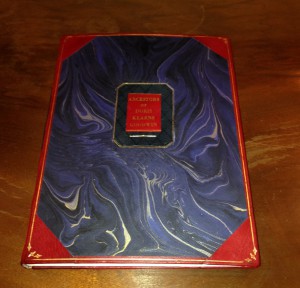 Every year at this time, the New England Historic Genealogical Society holds its annual meeting here in Boston. This year, the program began on Thursday with a lunch for board members, councilors, and other out-of-town guests, followed by tours of the Society’s new building at 97 Newbury Street and the new conservation laboratory at 99–101 Newbury Street. Friday was devoted to committee and other meetings for the board and council, culminating in a gala dinner where presidential historian Doris Kearns Goodwin received the Society’s Lifetime Achievement Award for American History and Biography. Ms. Goodwin was given a hand bound copy of a genealogy commissioned by the Society and compiled by Chris Child and David Allen Lambert, and she spoke to the group about “Everlasting Legacies”; her address had the epigraph “The people we love will live on so long as we pledge to tell and retell the stories of their lives.” Continue reading “To tell and retell the stories of their lives”
Every year at this time, the New England Historic Genealogical Society holds its annual meeting here in Boston. This year, the program began on Thursday with a lunch for board members, councilors, and other out-of-town guests, followed by tours of the Society’s new building at 97 Newbury Street and the new conservation laboratory at 99–101 Newbury Street. Friday was devoted to committee and other meetings for the board and council, culminating in a gala dinner where presidential historian Doris Kearns Goodwin received the Society’s Lifetime Achievement Award for American History and Biography. Ms. Goodwin was given a hand bound copy of a genealogy commissioned by the Society and compiled by Chris Child and David Allen Lambert, and she spoke to the group about “Everlasting Legacies”; her address had the epigraph “The people we love will live on so long as we pledge to tell and retell the stories of their lives.” Continue reading “To tell and retell the stories of their lives”
“Very serviceable”: Maidservants in New England, 1638-41
 Young men and women of relatively high status, including the children of close relatives, passed through the households of the Winthrops and their friends: it was a rite of passage. Continue reading “Very serviceable”: Maidservants in New England, 1638-41
Young men and women of relatively high status, including the children of close relatives, passed through the households of the Winthrops and their friends: it was a rite of passage. Continue reading “Very serviceable”: Maidservants in New England, 1638-41
“The place where you are”: letters to New England, 1631-36
 As I read through the third volume of the Winthrop Papers, one of the Winthrop correspondents I have most enjoyed is Edward Howes, described succinctly in a footnote as a “student of law, alchemist and mystic, clerk to [John1 Winthrop’s brother-in-law] Emmanuel Downing, [and] friend of the younger John Winthrop.” (Volume 2, p. 226) I find myself looking forward to Howes’ letters’ salutations, and to the mixture of folk wisdom, political intrigue, and religious fervor I find within their pages. At times Howes and John2 Winthrop sound like the young men they were, not far removed from university punning; in other letters, Howes can be quite formal and business-like as he fulfills commissions for the Winthrops and the Downings. Continue reading “The place where you are”: letters to New England, 1631-36
As I read through the third volume of the Winthrop Papers, one of the Winthrop correspondents I have most enjoyed is Edward Howes, described succinctly in a footnote as a “student of law, alchemist and mystic, clerk to [John1 Winthrop’s brother-in-law] Emmanuel Downing, [and] friend of the younger John Winthrop.” (Volume 2, p. 226) I find myself looking forward to Howes’ letters’ salutations, and to the mixture of folk wisdom, political intrigue, and religious fervor I find within their pages. At times Howes and John2 Winthrop sound like the young men they were, not far removed from university punning; in other letters, Howes can be quite formal and business-like as he fulfills commissions for the Winthrops and the Downings. Continue reading “The place where you are”: letters to New England, 1631-36
“Between the bark and the tree”: ‘The Winthrop Woman,’ 1629
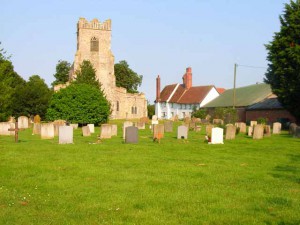
As I delve further into the Winthrop Papers, I am finding interesting asides about the relationships within the Winthrop family. Like his father, Governor John1 Winthrop (1588–1649) remained close to his “brothers” and “sisters,” such as Thomas Fones (d. 1629), the widower of Winthrop’s sister Anne, and Thomas’ second wife, Priscilla (Burgess) (Sherman) (Fones) Paynter, the future governor’s “verye louinge sister Mrs. Fones.” Continue reading “Between the bark and the tree”: ‘The Winthrop Woman,’ 1629
Organizing a family reunion: Part One
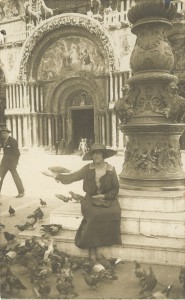
My mother used to say, wistfully, “You’re always writing about your father’s family; I wish you would write about mine.” Vita Brevis readers will remember the posts on my Great-Grandfather Glidden and the fruitful search for his photograph; with this post, I trust I will begin paying down the arrears on my mother’s mother’s mother’s family, the Bouchers.
My great-grandmother Pauline Boucher (1875–1964) was the sixteenth of the twenty-three children born in Baltimore to her father, William Boucher, Jr. (1822–1899), and the seventh of the fourteen born to her mother, Mary Frances (Giles) Boucher (1843–1923). While the size of the family is impressive, I should note that about half the children died young, and only one child of Boucher’s first marriage (to Mary Agnes O’Brien) lived to grow up and marry. This was Francis Xavier Boucher (1854–1927), who was thirty-three years older than the last-born child, Constance Marie (Boucher) Burch (1887–1977). Nine of the Boucher children married, but only five – Frank Boucher, Josephine Stone, Gertrude Donovan, Pauline Glidden, and Constance Burch – have living descendants. Continue reading Organizing a family reunion: Part One
Voices from the sixteenth and seventeenth centuries
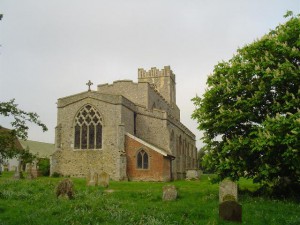
One of my current projects is a new genealogy of the Winthrop family of Suffolk in England and then Massachusetts Bay in New England. I am in the process of reading through the Winthrop Papers, a six-volume collection of documents associated with the family in England and America – including many letters by family members, friends, and associates – during the sixteenth, seventeenth, and eighteenth centuries. Of particular interest in Volume 1 is the diary kept by AdamA Winthrop (1548–1623), the father of Governor John1 Winthrop of Massachusetts Bay. Continue reading Voices from the sixteenth and seventeenth centuries
Object Lessons
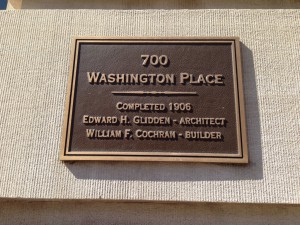 I recently paid a visit to Baltimore to photograph some of the surviving architectural commissions of my great-grandfather Edward Hughes Glidden. I had a great time traversing the city, from Battle Monument Square to Druid Hill Park, from the financial district to South and East Baltimore, and then out to Johns Hopkins’ Homewood campus, Roland Park, and Guilford.
I recently paid a visit to Baltimore to photograph some of the surviving architectural commissions of my great-grandfather Edward Hughes Glidden. I had a great time traversing the city, from Battle Monument Square to Druid Hill Park, from the financial district to South and East Baltimore, and then out to Johns Hopkins’ Homewood campus, Roland Park, and Guilford.
Some of Glidden’s buildings have fallen into disrepair – the Seventh Baptist and Second German Evangelical Churches are sad examples – while others are evidently well cared for and even loved. Best of all, on my first morning in the city I photographed the marker at the entrance to the Washington Apartments (1905–6) on Washington Place, where Glidden and his patron William F. Cochran are still memorialized. Continue reading Object Lessons
An interview with Marilynne Roach: Part Two
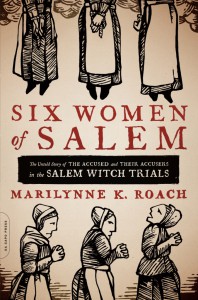 Marilynne K. Roach will lecture tonight at 6 p.m. at the New England Historic Genealogical Society (99-101 Newbury Street in Boston). Marilynne’s most recent book is Six Women of Salem: The Untold Story of the Accused and Their Accusers in the Salem Witch Trials, published by Da Capo Press.
Marilynne K. Roach will lecture tonight at 6 p.m. at the New England Historic Genealogical Society (99-101 Newbury Street in Boston). Marilynne’s most recent book is Six Women of Salem: The Untold Story of the Accused and Their Accusers in the Salem Witch Trials, published by Da Capo Press.
Scott C. Steward: You have written on a variety of subjects for a variety of audiences. What is it about Salem and the witchcraft trials that keeps you interested in the subject? Continue reading An interview with Marilynne Roach: Part Two
